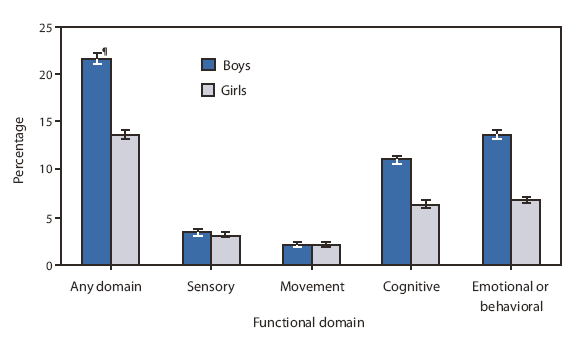Persons using assistive technology might not be able to fully access information in this file. For assistance, please send e-mail to: mmwrq@cdc.gov. Type 508 Accommodation and the title of the report in the subject line of e-mail.
QuickStats: Prevalence of Functional Difficulties* Among Children Aged 5--17 Years, by Functional Domain† and Sex --- National Health Interview Survey,§ United States, 2001--2007

* Functional difficulty in children is defined as difficulty in any of the following four functional domains: sensory, movement, cognitive, or emotional or behavioral.
† Based on responses to multiple questions, which can be found in Table 1 of the source publication. Sensory difficulty represents difficulty with seeing or hearing. Movement difficulty is difficulty walking, running, or playing. Cognitive difficulty represents difficulty remembering or having mental retardation, Down syndrome, autism, or learning disability. Emotional or behavioral difficulty represents attention deficit hyperactivity disorder or difficulty with emotions, concentration, behavior, or being able to get along with other persons.
§ Estimates are based on household interviews of a sample of the civilian, noninstitutionalized U.S. population and are derived from the National Health Interview Survey sample child component. Responses for children were obtained from a knowledgeable adult residing in the household, usually a parent.
¶ 95% confidence interval.
During 2001--2007, approximately 18% of children aged 5--17 years had functional difficulty in one or more of the following four domains: sensory, movement, cognitive, or emotional or behavioral functioning. Overall, approximately 22% of boys and 14% of girls were reported to have functional difficulty. Rates of functional difficulty were similar among boys and girls for the sensory and movement domains; however, boys were more likely than girls to have difficulty in the cognitive and emotional or behavioral domains.
SOURCE: Pastor PN, Reuben CA, Loeb M. Functional difficulties among school-aged children: United States, 2001--2007. National health statistics reports; no. 19. Hyattsville, MD: National Center for Health Statistics; 2009. Available at http://www.cdc.gov/nchs/data/nhsr/nhsr019.pdf.
Alternate Text: The figure above shows the prevalence of functional difficulties among children aged 5-17 years, by functional domain and sex in the United States from 2001-2007. During 2001-2007, approximately 18% of children aged 5-17 years had functional difficulty in one or more of the following four domains: sensory, movement, cognitive, or emotional or behavioral functioning. Overall, approximately 22% of boys and 14% of girls were reported to have functional difficulty. Rates of functional difficulty were similar among boys and girls for the sensory and movement domains; however, boys were more likely than girls to have difficulty in the cognitive and emotional or behavioral domains.
Use of trade names and commercial sources is for identification only and does not imply endorsement by the U.S. Department of
Health and Human Services.
References to non-CDC sites on the Internet are
provided as a service to MMWR readers and do not constitute or imply
endorsement of these organizations or their programs by CDC or the U.S.
Department of Health and Human Services. CDC is not responsible for the content
of pages found at these sites. URL addresses listed in MMWR were current as of
the date of publication.
All MMWR HTML versions of articles are electronic conversions from typeset documents.
This conversion might result in character translation or format errors in the HTML version.
Users are referred to the electronic PDF version (http://www.cdc.gov/mmwr)
and/or the original MMWR paper copy for printable versions of official text, figures, and tables.
An original paper copy of this issue can be obtained from the Superintendent of Documents, U.S.
Government Printing Office (GPO), Washington, DC 20402-9371;
telephone: (202) 512-1800. Contact GPO for current prices.
**Questions or messages regarding errors in formatting should be addressed to
mmwrq@cdc.gov.
 ShareCompartir
ShareCompartir


